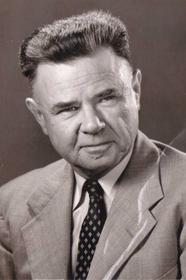Editorial
Ice Fishing
Monday, September 10, 2012

County Surveyor W. H. "Bill" Ice in 1958. He discovered that Felix Robbins knew all about the vanished creek.
[Photo courtesy of his son, Charlie Ice]
Bill Ice served as county surveyor for 27 years in New Madrid County.
In the 1960s he was surveying south of New Madrid in preparation of the St. Jude Industrial Park. The survey was along the banks of the Mississippi River, and he ran into a common problem in his business: the river had moved and all the old survey markers had fallen into the river. The line he was trying to establish ran along an old creek that appeared on early maps. The creek was also nowhere to be found.
The solid river bank gave no clue to its original location either.
It just so happened that the area he was surveying was in the vicinity of the boyhood home of Felix Robbins. A civil engineer, Felix had served a two year term as county surveyor beginning in 1913.
Today, the Robbins farm is part of the Industrial Park; the family home demolished.
Bill gathered up his charts and went to see Felix hoping he could help.
Born in 1887, Felix was then in his late 70s when Bill called on him.
With the maps rolled out on the table, Bill explained his survey problem and the need to locate the old creek on the new chart.
Felix studied the maps and the area and told Bill that when he was a boy he fished in that creek where it emptied into the river. There was a heavily shaded dirt road that ran along the river coming from New Madrid to the area of their farm, and, close to the river, a wooden bridge crossed the creek near where he fished. He pointed out the area on Bill's maps.
To make his point, he told Bill about one particular fishing trip on the creek.
One hot summer day, Felix had finished fishing and started walking home. When he reached the bridge, there sat a wagon parked in the middle of the bridge. The driver and the two horses were all sound asleep. The leather reins hung slack in the driver's hands, and his head was dropped against his chest with his hat drawn down over his eyes. Felix didn't recognize the driver or the rig. On the flatbed of the wagon was a large block of melting ice draped with a piece of tarp. The water was dripping through the wagon slats. Underneath the wagon the bridge was a wet dark chocolate brown, so they must have been "resting" there for quite a while.
New Madrid, where the ice house was located, was several miles distant. All of the farms in the area sent a wagon to New Madrid several times a week for ice.
Felix said he walked up behind the wagon and, thinking he would wake the driver, tapped his fishing pole against the back of the bed.
Tap. Tap.
The driver didn't wake up, but the horses did. They both jolted and took off at a dead run with the wagon in tow.
On the first curve off went the driver, and on the second curve off went what remained of the ice. The horses and wagon disappeared down the road with the driver frantically running after. Felix stepped off the road to avoid being seen until the driver was out of sight.
Felix told Bill that the driver must have caught it good from the lady of the house when he finally made it to the farm with neither wagon nor ice--his sole duty of the day.
Most probably, he didn't make any more of the ice trips to New Madrid either.


